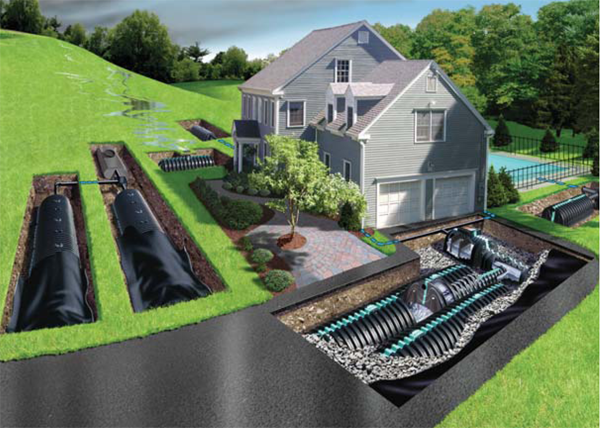
Unveiling Effective Water Drainage Solutions for a Dry and Secure Property
In an era marked by increasingly unpredictable weather patterns, the importance of maintaining effective water drainage around your property cannot be overstated. Problems stemming from inadequate drainage, such as flooding, erosion, and potential damage to your home’s foundation, underscore the need for proactive solutions. This article delves into accessible and efficient water drainage strategies that individuals can employ to protect their properties.
Understanding the Importance of Water Drainage:
Before delving into solutions, it’s essential to grasp why proper water drainage matters.
Stagnant water encircling your home has the potential to undermine soil strength, erode landscaping features, and jeopardize the structural soundness of your property. Furthermore, the accumulation of water serves as an ideal breeding ground for mosquitoes and various pests, introducing health risks to the surrounding environment.
Gutters and Downspouts:
One of the most straightforward yet effective water drainage solutions is ensuring your gutters and downspouts are in good condition. Clean gutters regularly to prevent debris buildup, which can lead to clogs and hinder proper water flow. Extend downspouts away from the foundation, directing water at least 3 feet away to avoid water accumulation around your home.
Grading the Landscape:
Proper grading is a fundamental aspect of efficient water drainage. Ensure that your landscape slopes away from your home, directing water toward appropriate drainage areas. This prevents water from pooling around your foundation and encourages it to flow away from your property.
French Drains:
French drains are underground drainage systems designed to redirect water away from specific areas. They consist of a perforated pipe surrounded by gravel and are particularly useful in areas prone to excess water buildup. Installing a French drain can be a game-changer for eliminating standing water in your yard.
Swales:
A swale is a shallow, open drainage channel often used to manage water flow in a specific direction. By strategically incorporating swales into your landscape, you can effectively guide water away from sensitive areas. Swales are particularly useful in preventing erosion and promoting water absorption.
Rain Barrels:
Harnessing rainwater through the use of rain barrels is a sustainable water drainage solution. Connect rain barrels to your downspouts to collect rainwater, which can then be used for watering plants or other non-potable purposes. This not only reduces the strain on municipal water sources but also helps prevent excess water around your property.
Regular Maintenance:
Consistent maintenance is key to ensuring the effectiveness of any water drainage solution. Keep an eye on your gutters, downspouts, and drainage systems, and promptly address any issues. Regularly inspect your landscape’s grading and make adjustments as needed to maintain proper water flow.
The Role of Professional Assessment:
While many of the aforementioned solutions are manageable as DIY projects, sometimes seeking professional advice is crucial. Consider engaging a landscaping or drainage expert to assess your property. Their trained eyes can identify specific issues and recommend tailored solutions, ensuring a more comprehensive and effective approach to water drainage.
Sump Pumps:
For homes with basements or crawl spaces prone to flooding, installing a sump pump can be a game-changer. Sump pumps efficiently pump out excess water that accumulates in a designated sump basin, preventing water damage to your home’s foundation. Regularly test and maintain your sump pump to ensure it’s in optimal working condition when you need it.
Green Roofs:
Green roofs, covered with vegetation, provide an innovative solution to water drainage while offering additional environmental benefits. The vegetation absorbs rainwater, reducing runoff and providing insulation for your home. While green roofs may require a more significant initial investment, their long-term advantages make them a sustainable choice.
Channeling Water with Berms:
Berms are raised mounds of soil strategically placed to redirect water flow. By creating berms along the natural contours of your landscape, you can channel water away from vulnerable areas. Berms not only serve a practical purpose but can also enhance the visual appeal of your outdoor space.
Smart Landscaping Choices:
Choosing the right plants can significantly contribute to effective water drainage. Opt for native plants with deep root systems that help stabilize soil and absorb excess water. These plants not only thrive in the local climate but also play a role in preventing soil erosion and promoting a healthier ecosystem.
DIY Rain Chain:
Enhance the visual appeal of your property while addressing water drainage by installing a DIY rain chain. A rain chain is a decorative alternative to a traditional downspout, guiding water from your gutters to the ground in a visually pleasing way. This simple addition can be both functional and aesthetically pleasing, adding a unique touch to your home.
Educating Yourself:
Understanding your local climate and drainage patterns is crucial in implementing effective solutions. Familiarize yourself with the topography of your area, identifying potential sources of water accumulation. By staying informed, you can make informed decisions about which water drainage solutions are most suitable for your specific circumstances.
Conclusion: Taking Charge of Your Property’s Water Management:
In conclusion, managing water drainage around your property is not just about preventing immediate issues but also about fostering a sustainable and secure living environment. Whether you opt for simple, DIY solutions or more complex professional interventions, each step you take contributes to the resilience of your property.
FAQS:
- Why is proper water drainage important for my property?
Efficient water drainage safeguards your property from potential damage, including flooding and erosion. It also prevents issues like soil weakening and structural compromise, ensuring the longevity of your home.
- Can I implement these water drainage solutions myself?
Yes, many solutions, such as cleaning gutters and adjusting landscape grading, are DIY-friendly. However, for more complex interventions like French drains or professional assessments, consulting experts is advisable for optimal results.
- Are these solutions environmentally friendly?
Absolutely. Solutions like rain gardens, permeable paving, and green roofs not only address water drainage but also contribute positively to the environment by reducing runoff, promoting sustainability, and enhancing the overall ecological balance.



